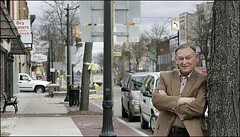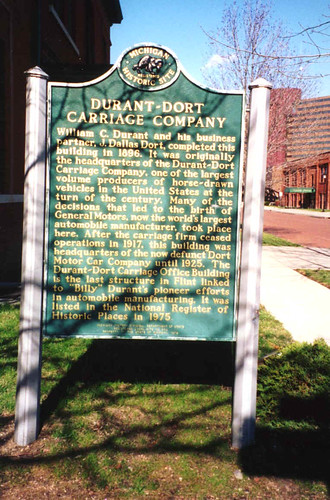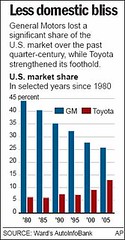Michigan's factory towns (continue to) fade
 Dale G. Young / The Detroit News. "No matter what happens to the city, manufacturing jobs will be less," Greenville Mayor Lloyd Walker says.
Dale G. Young / The Detroit News. "No matter what happens to the city, manufacturing jobs will be less," Greenville Mayor Lloyd Walker says.I often wonder what policy prescriptions I would suggest in contracting-declining markets. I had a conversation with a colleague yesterday and we were talking about Baltimore. There are thousands upon thousands of vacant rowhouses in Baltimore. Fortunately, Baltimore is in the Northeast Corridor, between DC and NYC, so it has the benefit of location. Greenville, Michigan, in the relatively under-populated western part of the state, does not.
See "Factory towns fade in Michigan: Greenville's fears of becoming a ghost town mirror worries in other struggling communities," from the Detroit News. From the article:
At Dazzlin' Digits Nail Salon, customers book fewer manicures and have begun paying their bills with credit cards. At Huckleberry's restaurant, where business also has dropped, the owner slashed his staff from 30 to 19 and took away their insurance and retirement plan. This bucolic west Michigan community, a company town that lost its company, has become a microcosm of the economic upheaval in the state.
Greenville's problems, which include the closings and announced closings of three major factories in 15 months, are eating away at the essence of a conservative community that has long believed in capitalism.
Residents whose lives have been turned upside down feel betrayed by the same institution they once championed. "We did everything we were supposed to," said Pat Hoisington, 59, who worked for Electrolux for 28 years before the refrigerator plant moved its operations to Mexico this year. "Why hurt your people like that?"
Greenville's troubles reflect what's happening in the state, which has lost 237,000 manufacturing jobs -- one-quarter of its total -- since 1999. While the national unemployment rate is 4.8 percent, it's 6.6 percent in Michigan and hovers above 10 percent in Greenville's Montcalm County.
The Big Three share of the U.S. market has withered from 70 percent a decade ago to 57 percent. The number of vehicles produced in the state fell from 3.4 million to 2.6 million during that time. Two of the major employers struggling in Greenville are auto-related: Tower Automotive and Federal Mogul.
As industry abandons Greenville, it's being replaced by huge commercial and residential growth as the town of 7,900 becomes more of an upscale bedroom community for Grand Rapids. Plans call for 1,250 homes in the next few years.
But the new houses and stores hold little attraction for unemployed factory workers who can't afford to live or shop there. They wonder if there will be a place for them in the future of their hometown.
Speaking of factory towns in Michigan, is there any hope for Flint? The article, "Flint losing last links to auto industry security: Residents wonder if there's a way to rebound as the population has shrunk along with GM's presence," doesn't offer a lot of hope...
 Flint was the birthplace of General Motors. See "Flint's early contributions to the auto industry, from the Michigan State University class website for the course "Geography of Michigan and the Great Lakes Region."
Flint was the birthplace of General Motors. See "Flint's early contributions to the auto industry, from the Michigan State University class website for the course "Geography of Michigan and the Great Lakes Region."( State of Michigan historic site markers illustrate the point I made earlier about the value of such markers in communicating about history.)
For Baltimore I suggest the eminent domain seizure of block after block of vacant housing and the creation of a new kind of "Homestead" plan, revitalizing areas in a focused manner, building a new critical mass of residents.
But my colleague (who lives in an urban suburb) says "what about the schools, what about public safety, the lack of amenities?"
Revitalization is difficult, at least cities like Baltimore have the advantage of compact development. But still, it comes down to working to attract higher income residents. At least with vacant housing, it's not an issue of displacement. Is it?
And from the Philadelphia Inquirer, see "Local firm faces fight to survive," about automobile parts remanufacturer Cardone Industries, the largest manufacturing company left in Philadelphia (4,500 jobs), and the difficulty it has in competing with newly manufactured auto parts from China.

Index Keywords: globalization



0 Comments:
Post a Comment
<< Home